Kenneth C. Davis's Blog, page 68
March 18, 2016
Marbury, Madison, Marshall, and McConnell

John Adams, Second POTUS , official portrit (Source: White House Historical Association)
[UPDATED]
On February 24, 1803 Chief Justice John Marshall delivered the unanimous opinion in Marbury v Madison.
Dust off your Civics books.
[UPDATED] President Obama has made his decision and nominated Merrick Garland to the Supreme Court.
As the fight over Judge Garland as Antonin Scalia’s replacement on the Supreme Court absorbs the country, and Senate Majority Leader Mitch McConnell has vowed to block any appointments by President Obama during his last year in office, it might help to look at history.
The simple fact is that the most consequential Supreme Court appointment in American history was made by a true “lame duck” President.
In its original sense, “lame duck” meant a president or other elected official whose successor had already been chosen.

John Marshall Chief Justice of the Supreme Court
(Reproduction courtesy of the Supreme Court Historical Society)
In 1801, after it was certain that president John Adams would not return for a second term, Adams nominated his Secretary of State, John Marshall, to the post to replace ailing Chief Justice Oliver Ellsworth.
At the time of this nomination, President Adams was a true “lame duck” president, soon to be replaced by Thomas Jefferson, following a drawn-out vote in the House of Representatives. It was clear that Jefferson’s party would control both the White House and the Senate. But Adams named Marshall, a staunch Federalist of his own party, who was confirmed despite only six-weeks of legal training.
One of Marshall’s first and most significant decisions came in the 1803 case of Marbury v. Madison which established the power of federal courts to void acts of Congress in conflict with the Constitution.
It is emphatically the province and duty of the judicial department to say what the law is. . . . Thus the particular phraseology of the constitution of the United States confirms and strengthens the principle, supposed to be essential to all written constitutions, that a law repugnant to the constitution is void. . . .
From Chief Justice Marshall’s decision in Marbury v. Madison
John Marshall went on to become the longest-serving and most influential chief justice in the history of the Supreme Court, hearing more than 1,000 cases and writing 519 decisions.
There have been more election year nominations, as discussed in this New York Times Op-Ed, “In Election Years, a History of Conforming Court Nominees.”
As John Adams himself said during the Boston Massacre Trial (1770)
“Facts are stubborn things.”
THE HIDDEN HISTORY OF AMERICA AT WAR-In Paperback May 2016
Coming in paperback in May 2016
The Hidden History of America At War: Untold Tales From Yorktown To Fallujah
THE HIDDEN HISTORY OF AMERICA AT WAR: Untold Tales from Yorktown to Fallujah is a unique, myth-shattering, and insightful look at war—why we fight, who fights our wars and what we need to know but perhaps never learned about the growth and development of America’s military forces.Read more about the book and critical praise here
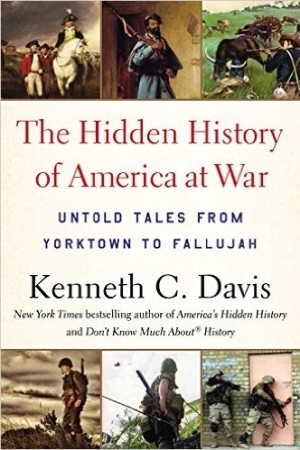
In paperback May 2016 THE HIDDEN HISTORY OF AMERICA AT WAR: Untold Tales from Yorktown to Fallujah
Marbury, Madison, Marshall, and McConnell
[UPDATED]
On February 24, 1803 Chief Justice John Marshall delivered the unanimous opinion in Marbury v Madison.

John Adams, Second POTUS , official portrit (Source: White House Historical Association)
Dust off your Civics books.
[UPDATED] President Obama has made his decision and nominated Merrick Garland to the Supreme Court.
As the fight over Judge Garland as Antonin Scalia’s replacement on the Supreme Court absorbs the country, and Senate Majority Leader Mitch McConnell has vowed to block any appointments by President Obama during his last year in office, it might help to look at history.
The simple fact is that the most consequential Supreme Court appointment in American history was made by a true “lame duck” President.
In its original sense, “lame duck” meant a president or other elected official whose successor had already been chosen.

John Marshall Chief Justice of the Supreme Court
(Reproduction courtesy of the Supreme Court Historical Society)
In 1801, after it was certain that president John Adams would not return for a second term, Adams nominated his Secretary of State, John Marshall, to the post to replace ailing Chief Justice Oliver Ellsworth.
At the time of this nomination, President Adams was a true “lame duck” president, soon to be replaced by Thomas Jefferson, following a drawn-out vote in the House of Representatives. It was clear that Jefferson’s party would control both the White House and the Senate. But Adams named Marshall, a staunch Federalist of his own party, who was confirmed despite only six-weeks of legal training.
One of Marshall’s first and most significant decisions came in the 1803 case of Marbury v. Madison which established the power of federal courts to void acts of Congress in conflict with the Constitution.
It is emphatically the province and duty of the judicial department to say what the law is. . . . Thus the particular phraseology of the constitution of the United States confirms and strengthens the principle, supposed to be essential to all written constitutions, that a law repugnant to the constitution is void. . . .
From Chief Justice Marshall’s decision in Marbury v. Madison
John Marshall went on to become the longest-serving and most influential chief justice in the history of the Supreme Court, hearing more than 1,000 cases and writing 519 decisions.
There have been more election year nominations, as discussed in this New York Times Op-Ed, “In Election Years, a History of Conforming Court Nominees.”
As John Adams himself said during the Boston Massacre Trial (1770)
“Facts are stubborn things.”
Read more about Marbury v Madison in Don’t Know Much About History

Don’t Know Much About® History: Anniversary Edition (Harper Perennial and Random House Audio)
March 17, 2016
When Irish Eyes Were Not Smiling-The Bible Riots
(This is a revised version of a post that originally appeared on March 17, 2012)
It is the day for the “wearing of the green,” parades and an unfortunate connection between being Irish and imbibing. For the day, everybody feels “a little Irish.”
But it was not always a happy go lucky virtue to be Irish in America. Once upon a time, the Irish –and specifically Irish Catholics– were vilified by the majority in White Anglo-Saxon Protestant America. The Irish were considered the dregs by “Nativist” Americans who leveled at Irish immigrants all of the insults and charges typically aimed at every hated immigrant group: they were lazy, uneducated, dirty, disease-ridden, a criminal class who stole jobs from Americans. And dangerous. The Irish were said to be plotting to overturn the U.S. government and install the Pope in a new Vatican.
One notorious chapter in the hidden history of Irish-Americans is left out of most textbook– the violently anti-Catholic, anti-Irish “Bible Riots” of 1844.
In May 1844, Philadelphia –the City of Brotherly Love– was torn apart by a series of bloody riots. Known as the “Bible Riots,” they grew out of the vicious anti-immigrant and anti-Catholic sentiment that was so widespread in 19th century America. Families were burned out of their homes. Churches were destroyed. And more than two dozen people died in one of the worst urban riots in American History.
You can read more about America’s history of intolerance –religious and otherwise– in this Smithsonian essay, “America’s True History of Religious Tolerance.”
March 15, 2016
Don’t Know Much About® Andrew Jackson

Imacon Color Scanner
(Revision of original post of March 15, 2014. Video created and directed by Colin Davis.)
Andrew Jackson, the 7th President of the United States, was born on March 15, 1767 on the border of both South and North Carolina (the precise location is uncertain).
Does he deserve his place on the $20 bill?
In his day and ever since, Andrew Jackson has inspired high emotions and sharp opinions. Thomas Jefferson once called him, “A dangerous man. ”
His predecessor as president, John Quincy Adams, a bitter political rival, said Jackson was,
“A barbarian who could not even write a sentence of grammar and could hardly spell his own name.”
His place and reputation as an Indian fighter began with a somewhat overlooked fight against the Creek nation led by a half-Creek, half-Scot warrior named William Weatherford, or Red Eagle following an attack on an outpost known as Fort Mims north of Mobile, Alabama. Like Pearl Harbor or 9/11, it was an event that shocked the nation. Soon, Red Eagle and his Creek warriors were at war with Andrew Jackson, the Nashville lawyer turned politician, who had no love for the British or Native Americans.
You know the name of Andrew Jackson. But you probably don’t know the name William Weatherford. You should. He was a charismatic leader of his people who wanted freedom and to protect his land. Just like “Braveheart,” or William Wallace, of Mel Gibson fame. Only William Weatherford, or Red Eagle, wasn’t fighting a cruel King. He was at war with the United States government. And Andrew Jackson. This video offers a quick overview of Weatherford’s war with Jackson that ultimately led the demise of the Creek nation.
Here are some Jackson facts via the National Constitution Center.
Don’t Know Much About® Andrew Jackson
(Revision of original post of March 15, 2014. Video created and directed by Colin Davis.)
Andrew Jackson, the 7th President of the United States, was born on March 15, 1767 on the border of both South and North Carolina (the precise location is uncertain).
Does he deserve his place on the $20 bill?
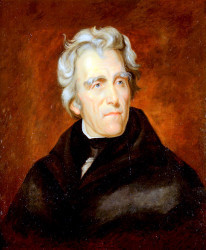 In his day and ever since, Andrew Jackson has inspired high emotions and sharp opinions. Thomas Jefferson once called him, “A dangerous man. ”
In his day and ever since, Andrew Jackson has inspired high emotions and sharp opinions. Thomas Jefferson once called him, “A dangerous man. ”
His predecessor as president, John Quincy Adams, a bitter political rival, said Jackson was,
“A barbarian who could not even write a sentence of grammar and could hardly spell his own name.”
His place and reputation as an Indian fighter began with a somewhat overlooked fight against the Creek nation led by a half-Creek, half-Scot warrior named William Weatherford, or Red Eagle following an attack on an outpost known as Fort Mims north of Mobile, Alabama. Like Pearl Harbor or 9/11, it was an event that shocked the nation. Soon, Red Eagle and his Creek warriors were at war with Andrew Jackson, the Nashville lawyer turned politician, who had no love for the British or Native Americans.
You know the name of Andrew Jackson. But you probably don’t know the name William Weatherford. You should. He was a charismatic leader of his people who wanted freedom and to protect his land. Just like “Braveheart,” or William Wallace, of Mel Gibson fame. Only William Weatherford, or Red Eagle, wasn’t fighting a cruel King. He was at war with the United States government. And Andrew Jackson. This video offers a quick overview of Weatherford’s war with Jackson that ultimately led the demise of the Creek nation.
Here are some Jackson facts via the National Constitution Center.
You can also read more about William Weatherford, Andrew Jackson, and Jackson’s role in American history in A NATION RISING. Andrew Jackson’s life and presidency are also covered in Don’t Know Much About® the American Presidents.
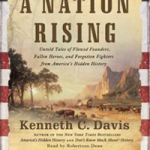
A NATION RISING

Don’t Know Much About® the American Presidents
March 14, 2016
“In the Shadow of Liberty”-Coming in September 2016
I am thrilled to introduce the Advance Reader’s Edition of my forthcoming book:
IN THE SHADOW OF LIBERTY — The Hidden History of Slavery, Four Presidents, and Five Black Lives
Set for release on September 20, 2016, the book will be published by Holt Books for Young Readers. The book offers narrative accounts of five enslaved people who were the legal property of George Washington, Thomas Jefferson, James Madison, and Andrew Jackson.
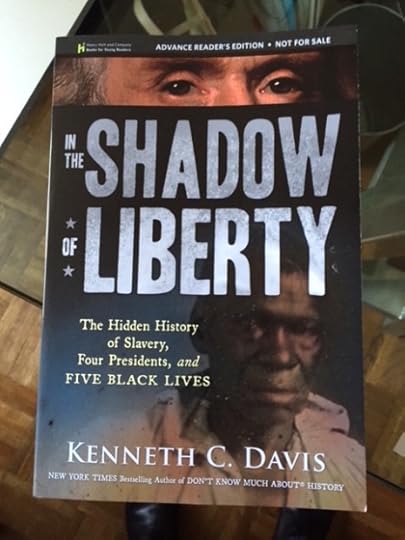 Contact Holt Books for Young Readers for review copies and publicity requests.
Contact Holt Books for Young Readers for review copies and publicity requests.
Books for Young Readers
Henry Holt and Company
175 Fifth Avenue
New York, NY 10010
To request an author for an interview, please email: byrpublicity@hholt.com.
If you would like to receive a catalog or a review copy of a book, please fax the request on your letterhead to 646-307-5247.
Don’t Know Much About® Eli Whitney (A TED-Ed “Lesson Worth Sharing”)
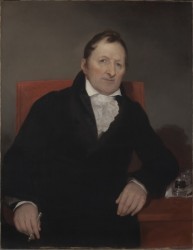
“Eli Whitney,” portrait of the inventor, oil on canvas, by the American painter Samuel F. B. Morse. 35 7/8 in. x 27 3/4 in. Courtesy of the Yale University Art Gallery, Yale University, New Haven, Conn.
On March 14, 1793, Eli Whitney received a patent for the machine known as the Cotton Gin. Here is a short video about the Connecticut-born inventor’s most famous “invention,” the Cotton Gin. This was created as my first contribution to Ted-Ed: “Lessons Worth Sharing.”
This portrait of the inventor is by another inventor– Samuel F.B. Morse who was a well-known painter and art teacher before he gained fame for the development of the telegraph and the Morse Code.
The cotton gin changed history for good and bad. By allowing one field hand to do the work of 10, it powered a new industry that brought wealth and power to the American South — but, tragically, it also multiplied and prolonged the use of slave labor. In this video, I discuss innovation, while warning of unintended consequences.
Eli Whitney died in New Haven, Connecticut on January 8, 1825. You can learn more about Whitney and his inventions at the Eli Whitney Museum and Workshop.
“In the Shadow of Liberty”-Coming in September 2016
I am thrilled to introduce the Advance Reader’s Edition of my forthcoming book:
IN THE SHADOW OF LIBERTY — The Hidden History of Slavery, Four Presidents, and Five Black Lives
Set for release on September 20, 2016, the book will be published by Holt Books for Young Readers. The book offers narrative accounts of five enslaved people who were the legal property of George Washington, Thomas Jefferson, James Madison, and Andrew Jackson.
 Contact Holt Books for Young Readers for review copies and publicity requests.
Contact Holt Books for Young Readers for review copies and publicity requests.
Books for Young Readers
Henry Holt and Company
175 Fifth Avenue
New York, NY 10010
To request an author for an interview, please email: byrpublicity@hholt.com.
If you would like to receive a catalog or a review copy of a book, please fax the request on your letterhead to 646-307-5247.
Who Said It? (3/12/2-16)

Abraham Lincoln (November 1863) Photo by Alexander Gardner
Abraham Lincoln, “Letter to Joshua Speed” (August 24, 1855)
“When the Know-Nothings get control, it will read ‘all men are created equal, except negroes, and foreigners, and Catholics.'”
Abraham Lincoln and Joshua Speed met in Springfield, Illinois, during the 1830s. Although Speed returned to his native Kentucky, they remained friends throughout life. In this letter, Lincoln expresses his thinking about slavery, which contrasted with Speed, who grew up on a plantation and owned slaves. The year before Lincoln wrote this letter, the Kansas-Nebraska Act passed Congress, repealing the Missouri Compromise of 1820, and opened the territories to slavery. The passage of this bill proved a turning point in Lincoln’s career. As he observed, “I was losing interest in politics, when the repeal of the Missouri Compromise aroused me again.”
Source and Complete Text: Abraham Lincoln Online

Don’t Know Much About® History: Anniversary Edition (Harper Perennial and Random House Audio)

Don’t Know Much About® the American Presidents (Hyperion Paperback-April 15, 2014)
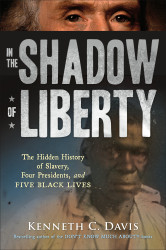
In the Shadow of Liberty- Publication date September 20, 2016 (Holt Books for Young Readers)



